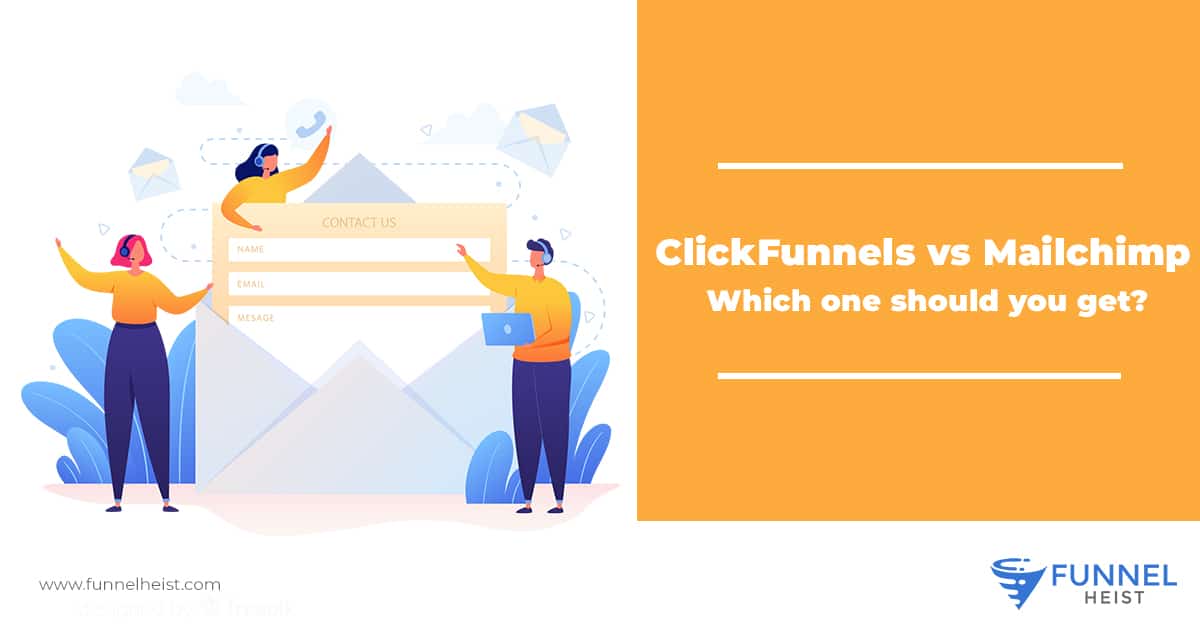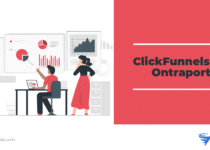ClickFunnels vs MailChimp
 ClickFunnels vs MailChimp: which is the better online marketing platform? In this post, we will take you through each software and help you make an informed decision on which is better to use for your needs.
ClickFunnels vs MailChimp: which is the better online marketing platform? In this post, we will take you through each software and help you make an informed decision on which is better to use for your needs.
First off, both platforms employ the sales funnel strategy to achieve marketing goals. A sales funnel is a series of marketing actions aimed to engage and direct potential customers to purchase a product or service. The steps involve the use of automated emails, videos, articles, opt-in forms, landing pages, and more. (Learn more about Sales Funnels here.)
ClickFunnels
Russell Brunson founded ClickFunnels in 2014 to help marketers easily create successful funnels. He wanted a world where eCommerce stores could sell their products through tried and tested methods. (READ: Everything you need to know about ClickFunnels)
ClickFunnels allows eCommerce stores to quickly build and develop different funnels, including sales funnels, to improve their marketing, their overall business operations, and simplify the purchasing process for their prospects and customers.
With ClickFunnels, you don’t have to have any coding knowledge or spend a significant amount of resources on hiring experts to build your funnel. When you subscribe to their varying bundles, you can develop your funnels quickly.
You can choose from their pre-designed templates or develop your own, even without any coding knowledge. Yes, you will spend to subscribe to their packages, but the return on investment is guaranteed when you use the right strategies.
How ClickFunnels works
ClickFunnels forces business owners to think about marketing their business through a sales funnel lens.
The ClickFunnels process is pretty simple. The first thing you have to do is create a landing page for a product or service. The landing page could be an opt-in form to capture the email addresses of the target customers.
When done, proceed with designing a sales page. This process would include writing a compelling copy for your product or service. A good sales copy is vital to increasing conversion rate.
Afterwards, create an order sign-up form and a membership portal. In this part, you will have the option to offer an upsell to your customer. Doing this should lead to more significant returns.
Once the sale is complete, deliver your product or service to your customer.
All these steps can happen in one platform only – ClickFunnels.
You can create your sales funnel or use any of the sample templates that come with your account. It has an easy customization process and you can also integrate it with other third-party programs like PayPal, Aweber, MailChimp, and so much more.
Features of ClickFunnels
ClickFunnels has many capabilities to improve its functionality.
- Sales Funnels
The ClickFunnels account comes with several templates for you to choose from. Its developers created these samples after an analysis of the market requirements, therefore giving you the best chance at a successful marketing campaign.
If you are not satisfied with any of the templates that ClickFunnels provides, you can create your own sales funnel. The creation process is straightforward, and there are directions provided to guide you.
No coding skills are required for you to build your sales funnel. It has a drag-and-drop editor that allows you to create different templates and pages and to redesign sales funnels in your ClickFunnels account. Take advantage of A/B testing to settle on the appropriate sales funnel for your campaign.
- Page elements
ClickFunnels has customizable page elements. You can change them to meet the specific needs of your customer base. The layout of your site is essential. You need to put headlines, images, video widgets, and buttons in the right place to improve the user experience. ClickFunnels allows you to set and reset them until they meet the needs of your customers.
- Integrations
E-commerce stores use different tools like GetResponse, Facebook, and Shopify, to improve their sales. ClickFunnels acknowledges that each of these platforms provides unique capabilities and benefits, which is why it lets you easily integrate these services with your ClickFunnels account.
Connecting these programs with your ClickFunnels will enable you to run simple processes and manage them.
- Tutorials
A lot of people do not like leaving their typical norms for new things. If you are a newbie to ClickFunnels, you can be sure that it will be manageable. ClickFunnels has many tutorials and learning resources that you can use to familiarize yourself with the platform.
You can find several videos on YouTube, learning materials on the website, and standby support available to guide you.
- Sales Funnel sharing
You can share your sales funnel with other people. When you share the URL of your sales funnel, it increases the number of people interacting with it.
ClickFunnels Pricing
ClickFunnels has a 14-day free trial for all users. If you are satisfied with the benefits and the capabilities of ClickFunnels, you can choose to subscribe to any of their two plans.
- ClickFunnels Startup
This plan goes for $97 a month. It allows you to build up to 20 funnels, with each having a maximum of 100 pages. You can connect it with up to 3 payment gateways and three domains.
- ClickFunnels Platinum
This plan goes for $297 each month. It allows you to create unlimited sales funnels, each with unlimited pages. You can connect this account with up to 9 payment gateways, up to 9 domains.
MailChimp
MailChimp is a popular email marketing service provider but not a lot of people know that you can use it to create landing pages.
MailChimp offers several plans that guarantee value for your money. It also provides a free package that allows users to send up to 12,000 emails each month.
How MailChimp works
There are several ways to create a funnel using MailChimp.
First, you will need to connect your business with your MailChimp account before you start. Then, create a landing page to enable it to collect emails or sell products.
If you choose to gather emails, you will need an automatic email sales sequence. This will allow you to send emails to your directory that seeks to convince members to buy from you. You can integrate your accounts like Shopify and PayPal with your Mailchimp to allow customers to follow simple steps until they make their payments.
Features of MailChimp
- Integrations
You can integrate your MailChimp account with several tools to boost your eCommerce sales. You can link it with PayPal, Shopify, and other social platforms. Connecting your accounts allows you to widen your reach and improve your processes.
- Analytics
MailChimp provides tracking capabilities to enable you to monitor the performance of your campaigns. You can track your conversions to know whether your efforts are yielding the results you want.
- Drag and Drop
Aside from the templates of landing pages, MailChimp allows you to customize them to suit your needs. You can edit the page elements like buttons and headlines. When you rearrange and change them, it will enable you to improve the customer experience.
- Learning materials
MailChimp provides different tools to help you familiarize yourself with the platform. You can find videos, texts, and an online community to help you take advantage of its capabilities.
MailChimp Pricing
MailChimp offers the following packages.
- New Business Plan
This is a free plan and allows small businesses to take advantage of the capabilities and benefits of MailChimp. However, you can only send 12,000 emails per month and have a list of up to 2,000 addresses.
- Growing Business Plan
This plan costs $10 per month and gives its users access to support, unlimited emails, predicted demographics, and more. You can also schedule the delivery of your messages according to different time zones.
- Pro Marketer Plan
This plan costs $199 a month and offers several capabilities and benefits to big companies. It provides subscribers with testing and comparative reports.
What is the difference between ClickFunnels and MailChimp?
ClickFunnels is a platform that allows you to build high-converting sales funnels to generate leads, create one-click upsells and webinars, grow your sales, and more. It comes with plenty of integrations to streamline your marketing efforts.
On the other hand, MailChimp is an email marketing software that allows you to market to your email list through newsletters and autoresponder campaigns. You can also build landing pages on MailChimp.
How do I use MailChimp with ClickFunnels?
Here are the steps that you can follow to integrate MailChimp with ClickFunnels.
- Log in to your ClickFunnels account and move on to your profile. Select Account Settings.
- Click on Integrations.
- Click Add New Integration.
- Look for MailChimp by typing MailChimp in the search bar. You will see MailChimp in the results. Click it.
- On the Add New Integration page, fill in the details by entering Integration Nickname: it can be any name. Next, paste your API Key from your MailChimp account.
- Click on Add Integration.
- You will be redirected to a MailChimp login page if you have not signed in your account. In here, you’ll consent that you agree to ClickFunnels accessing the data and information in your MailChimp account.
(READ MORE: How to integrate MailChimp with ClickFunnels)
The verdict: ClickFunnels is better than MailChimp
MailChimp is an email marketing platform first before it is anything else and is therefore more suited to businesses who want to focus on just that. Meanwhile, ClickFunnels is a better fit for those who want to work on their entire funnel. It has all the features that you will need to create a funnel including email marketing capabilities, building landing pages, and more.
If you have access to both applications, you can always integrate MailChimp into your ClickFunnels account. This way, you couple a powerful marketing platform with an efficient email marketing tool.


